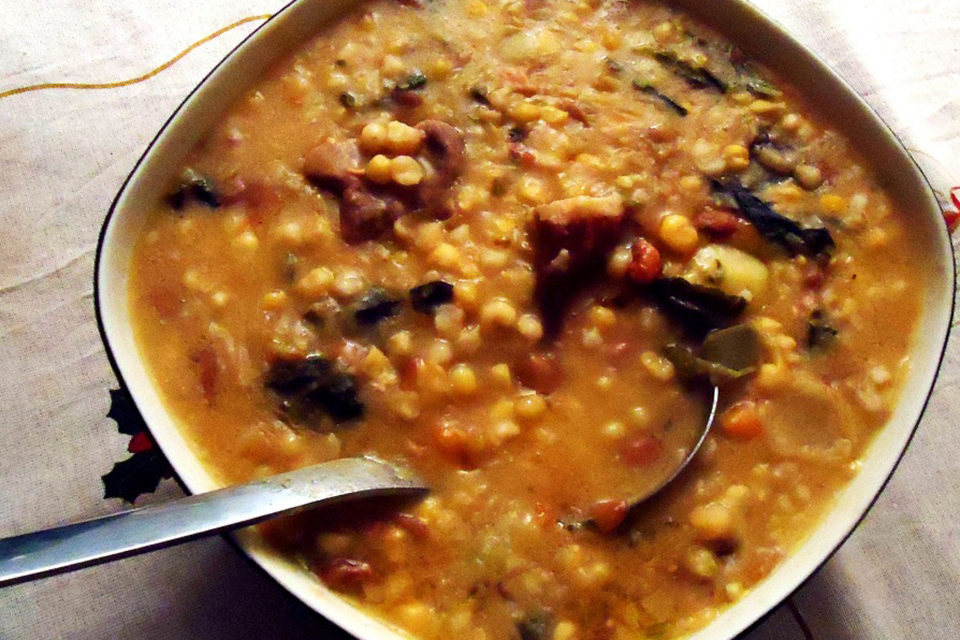I had heard about Cachupa, the national dish of Cape Verde. The first time I saw it was a news piece about the Onset Cape Verde Festival. They showed food that had been Americanized and some…”not so much.” The camera focusing in on a big pot of what looked like mush. If that is what Americans might find foreign, then that is what I wanted to try. So it was what I had my eye out for. I passed many a barbecue, chicken finger and steak and cheese type place to come to a sign that read “Cape Verde Foods”.
Side note. In middle school some of the Cape Verdean boys would poke fun at me, “Yo do you think Chinese girls are that pretty? Some of them maybe, but what that ….” Anyway the point seemed to be that Cape Verdean girls were statistically more beautiful. I will also mention that I went to middle school in inner city Boston and there are cultural preferences to beauty that would enable me use some street equivalent of “beauty is in the eye of the beholder.
However, now faced with a group of Cape Verdean female food servers, versus years of Chinatown experience of female food servers…. I will have to begrudgingly admit Cape Verde’s superiority and the accuracy of my classmates taunts. That being said, I was the only one in line and nobody was taking my order.
“How can I help you?”
“Uhh Can I get a Cachupa” spelled Kachupa on the sign, but I’ll go with Google’s spelling, “and ummmmm….” I looked for something that was spelled weird, and came across something that looked a lot like it said Kung Fu. “One… errr Gufong?”
“How many?” asked the young woman.
“Uhh… one?”
“Is that all?”
“What’s this?” I said pointing to something that looked like either an empanada or a Jamaican Beef Patty.”
“That’s a Jamaican Beef Patty.”
Shoot, I had those all the time in Middle school at Ruggles station all the time. I could have that anywhere. How is that even Cape Verdean?
“No thanks… what exactly is a Gufong anyway?”
“That.” said the girl pointing to what looked like a corn dog. I looked askance at it, because it looked like something very generic. Perhaps to her though, it looked like I was unsure of it’s contents. I would just like to say for the record, that I as a person of Chinese descent. I have eaten bull penis. I wouldn’t ORDER bull penis per se. I am just pointing out that I have eaten a lot of things most people won’t eat. I have also eaten dog. I usually lose friends really fast when I tell people that..
“It’s just like a fried corn sweet.” assured the girl.
I shrugged my shoulders. “Yeah okay just one of those and a Cachupa.”
I walked around, feeling special with the sweet fried corn donut thing in one hand for my starch and the cachupa in my other hand. I thought of sitting down and really savoring what I was eating. But it didn’t seem to be all that. Not like Fau Yuk Wonton mein, or some serious noodle dishes. It was good. But it wasn’t fantastic. It was basically bean soup and a donut. A filling meal. A hearty meal. A soup with meat, corn, and all sorts of goodness stewed together. But I wasn’t wowed.
How would I go about writing about this dish? Maybe my article would really enrage some people if this was THE national dish. They say Sancocho is like the Dominican Flag. Was Cachupa the equivalent in Cape Verde? I better be careful. Maybe I wouldn’t write the article after all.
But then I thought how a lot of “national dishes were this stew like thing. I mentioned Sancocho, but my Irish side also had recipes passed down generation to generation for Irish stew. I remember glancing at on my great grandmother hand wrote. What stood out was, “No Carrots! If there are Carrots it’s NOT Irish Stew.” The Chinese also had Jook. A rice porridge, which had various variations. New England had Clam Chowder. Chili Beans and rice was a comfort food to from my childhood. And southerners had grits. All of these were dishes that weren’t delicacies per se, but tied to memories of home, and a sense of identity. This Cachupa was pretty good, but just because I didn’t think it was amazing, didn’t mean that it wasn’t important.
I returned to my friends and later in the day I was asked, “So how did you like your Cachupa?”
I slowly shrugged my shoulders, “I mean it was… good.”
“Nah… hold off on that article you have to taste some REAL Cachupa first. Because I saw that stuff you was eating and it was all watery.”
I later heard this throughout the day. That Onset might be the biggest Festival.. But it was different from Brockton or Providence.
“Also all the island’s have a different recipe.” Another friend said defending the authenticity of what I had. “You really have to try it the home cooked way though.
And the more I learned about the dish, it really was more of a home cooked type meal and so I got the sense that, to insult Cachupa… may perhaps be like insulting someone’s mother.
My friend schooled me that indeed there were different recipes and that I had to have the dish that had more ingredients, not just cheap filler. Various vegetables, and meats, pork, chicken.., he licked his lips describing it and then said, “But… sometimes I don’t even like to eat my mother’s Cachupa that day. What I want to do is to wait for the next day. And that’s when you take it out of the fridge, through butter on the pan and THEN put on the Cachupa. You almost kind of fry it, except you don’t fry it because it’s so wet that it doesn’t fry. And if you have the kind with the pork then that kind of fries or maybe some of the edges get a little burnt but then that gets mixed into everything else.”
I thought of how crazy Chinese people sometimes went over the burnt parts of rice cooked in a clay pot.. Pouring tea over those bits and even calling that a meal. That “dish” has to be specially requested because usually nowadays Chinese cook rice in an electrical rice cooker. Fried Rice, was also a dish that was made from the leftover rice from the day before… fried again. Basically these dishes were originally a poor person’s way of not wasting food. But in the modern era, where food was plentiful, these dishes became grounded in a sense of tradition.
My friend continued… “You see you can talk about Cachupa, but then there is Cachupa Refogada. The one I just talked to you about, and I think a lot of people will like the one that is the day after. So you have to have all that first. Then you can talk about what you think about Cachupa.
So for the record.
This is the article ABOUT writing about Cachupa. It is not the ACTUAL article on Cachupa.





